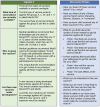From Qualitative Research to Quantitative Preference Elicitation: An Example in Invasive Meningococcal Disease
- PMID: 38388957
- PMCID: PMC11039532
- DOI: 10.1007/s40271-024-00677-8
From Qualitative Research to Quantitative Preference Elicitation: An Example in Invasive Meningococcal Disease
Abstract
Background: Qualitative research is fundamental for designing discrete choice experiments (DCEs) but is often underreported in the preference literature. We developed a DCE to elicit preferences for vaccination against invasive meningococcal disease (IMD) among adolescents and young people (AYP) and parents and legal guardians (PLG) in the United States. This article reports the targeted literature review and qualitative interviews that informed the DCE design and demonstrates how to apply the recent reporting guidelines for qualitative developmental work in preference studies.
Methods: This study included two parts: a targeted literature review and qualitative interviews. The Medline and Embase databases were searched for quantitative and qualitative studies on IMD and immunization. The results of the targeted literature review informed a qualitative interview guide. Sixty-minute, online, semi-structured interviews with AYP and PLG were used to identify themes related to willingness to be vaccinated against IMD. Participants were recruited through a third-party recruiter's database and commercial online panels. Interviews included vignettes about IMD and vaccinations and three thresholding exercises examining the effect of incidence rate, disability rate, and fatality rate on vaccination preferences. Participant responses related to the themes were counted.
Results: The targeted literature review identified 31 concepts that were synthesized into six topics for the qualitative interviews. Twenty AYP aged 16-23 years and 20 PLG of adolescents aged 11-17 years were interviewed. Four themes related to willingness to be vaccinated emerged: attitudes towards vaccination, knowledge and information, perception of IMD, and vaccine attributes. Most participants were concerned about IMD (AYP 60%; PLG 85%) and had positive views of vaccination (AYP 80%; PLG 60%). Ninety percent of AYP and 75% of PLG always chose vaccination over no vaccination, independent of IMD incidence rate, disability rate, or fatality rate.
Conclusion: Willingness to be vaccinated against IMD was affected by vaccine attributes but largely insensitive to IMD incidence and severity. This article provides an example of how to apply the recent reporting guidelines for qualitative developmental work in preference studies, with 21 out of 22 items in the guidelines being considered.
© 2024. The Author(s).
Conflict of interest statement
Joshua Coulter, Brett Hauber, Joseph C. Cappelleri, Paula Peyrani, Jessica Vespa Presa and Katharina Schley are employees and may hold stocks or stock options in Pfizer Inc.. Chiara Whichello, Sebastian Heidenreich, Christine Michaels-Igbokwe, and Malavika Venkatraman are employees of Evidera, which was paid by Pfizer for the development of this manuscript.
Figures





Similar articles
-
Preferences of US adolescents and parents for vaccination against invasive meningococcal disease.Vaccine. 2024 Nov 14;42(25):126264. doi: 10.1016/j.vaccine.2024.126264. Epub 2024 Sep 5. Vaccine. 2024. PMID: 39241319
-
Parental awareness and utilization of meningococcal serogroup B vaccines in the United States.BMC Public Health. 2020 Jul 14;20(1):1109. doi: 10.1186/s12889-020-09181-8. BMC Public Health. 2020. PMID: 32664872 Free PMC article.
-
Adolescent, parent and societal preferences and willingness to pay for meningococcal B vaccine: A Discrete Choice Experiment.Vaccine. 2016 Jan 27;34(5):671-677. doi: 10.1016/j.vaccine.2015.11.075. Epub 2015 Dec 28. Vaccine. 2016. PMID: 26740249
-
A review of the immunogenicity, safety and current recommendations for the meningococcal serogroup B vaccine, MenB-FHbp.J Clin Pharm Ther. 2020 Apr;45(2):270-281. doi: 10.1111/jcpt.13083. Epub 2019 Dec 9. J Clin Pharm Ther. 2020. PMID: 31820483 Review.
-
Invasive meningococcal disease in older adults in North America and Europe: is this the time for action? A review of the literature.BMC Public Health. 2022 Feb 23;22(1):380. doi: 10.1186/s12889-022-12795-9. BMC Public Health. 2022. PMID: 35197024 Free PMC article. Review.
Cited by
-
Quantifying Stated Preferences for Meningococcal Vaccines Among Adolescents/Young Adults and Parents of Adolescents in the United States: A Discrete Choice Experiment.Infect Dis Ther. 2024 Sep;13(9):2001-2015. doi: 10.1007/s40121-024-01017-x. Epub 2024 Jul 24. Infect Dis Ther. 2024. PMID: 39044053 Free PMC article.
-
The impact of regional disparities on the availability of meningococcal vaccines in the US.BMC Public Health. 2024 Jul 3;24(1):1771. doi: 10.1186/s12889-024-19081-w. BMC Public Health. 2024. PMID: 38961431 Free PMC article.
References
-
- Hollin IL, Craig BM, Coast J, Beusterien K, Vass C, DiSantostefano R, Peay H. Reporting formative qualitative research to support the development of quantitative preference study protocols and corresponding survey instruments: guidelines for authors and reviewers. Patient. 2020;13(1):121–136. - PubMed
-
- Tong A, Sainsbury P, Craig J. Consolidated criteria for reporting qualitative research (COREQ): a 32-item checklist for interviews and focus groups. Int J Qual Health Care. 2007;19(6):349–357. - PubMed
-
- de Jong Y, van der Willik EM, Milders J, Voorend CGN, Morton RL, Dekker FW, et al. A meta-review demonstrates improved reporting quality of qualitative reviews following the publication of COREQ- and ENTREQ-checklists, regardless of modest uptake. BMC Med Res Methodol. 2021;21(1):184. - PMC - PubMed
Publication types
MeSH terms
Substances
LinkOut - more resources
Full Text Sources
Medical
Miscellaneous

